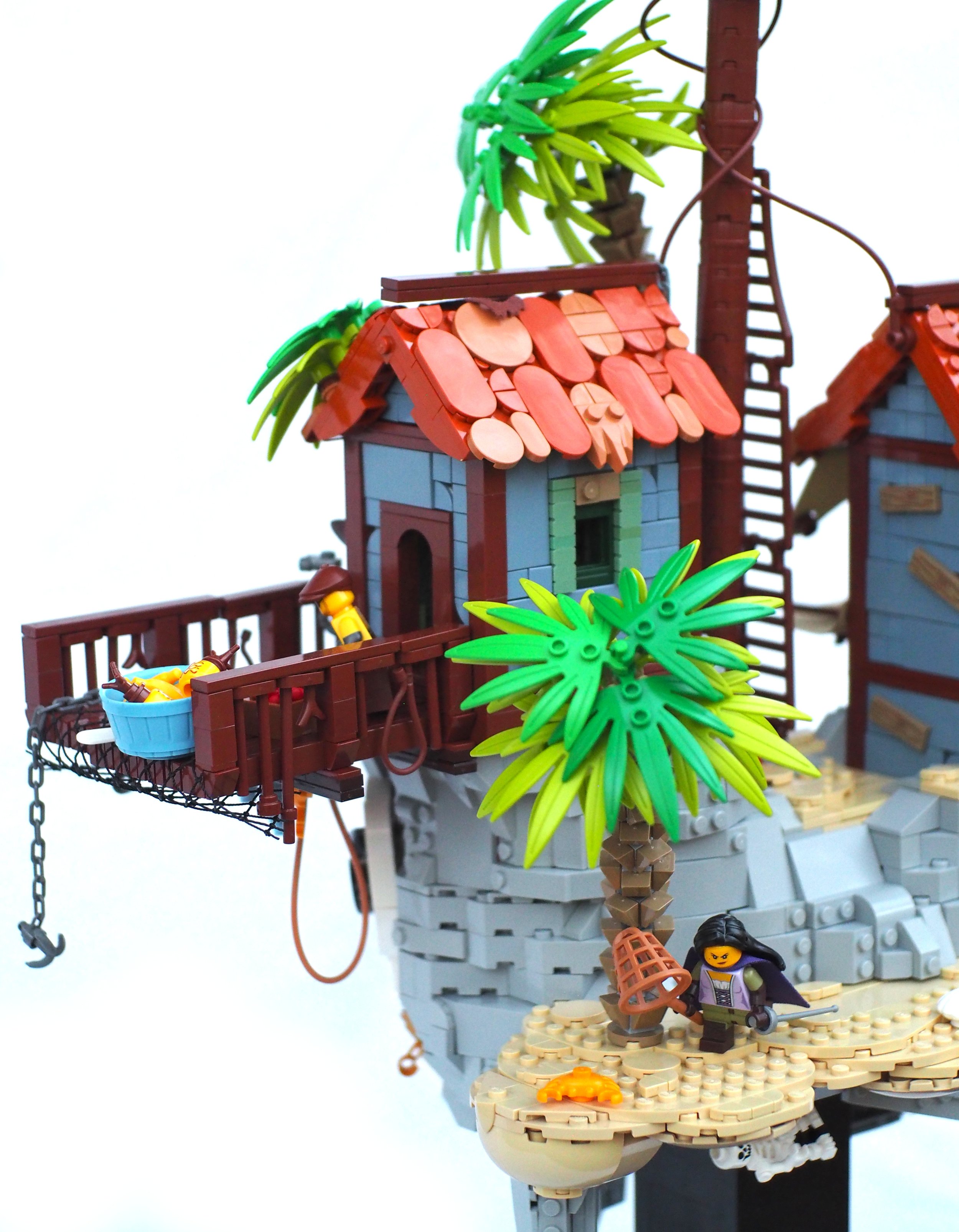The Future of LEGO: A Builder's Perspective on AI
/Previously, BrickNerd guest contributor Jesse Gros wrote a piece that, like any good article, left my mind’s wheels churning. I wondered, was artificial intelligence impacting the LEGO community? Could it change the way we build MOCs and truly break barriers for accessibility? Was effortless image spam disheartening MOC builders or just plain drowning them out with Instagram’s algorithm?
Good, bad, or ugly, AI has multiple sides—and you know me, I love to sit back and pontificate from the safety of a keyboard on tough topics. So I’m going to try my hand at answering the question: what does the future hold for LEGO fans? Could AI replace human creation of LEGO MOCs or even official sets?
AI and LEGO
Let’s begin with the obvious: right now, AI doesn’t understand the LEGO system. While some AI software can generate images that share design similarities with LEGO products and MOCs, a closer look quickly reveals that the contents of these images aren’t built out of LEGO bricks.
Yet it’s theoretically possible to combine AI with digital building software to create a machine that does understand how to put bricks together. In fact, not only is it theoretically possible, but it has been done: mosaic-building software “brickr” has been combined with AI so that a LEGO mosaic complete with instructions can be generated based on a text prompt. So the idea that someday you could input a line of text and come out with instructions to build, say, a new modular, is hardly science fiction. Love it or hate it, AI has the potential to create LEGO builds.
AI and the Building Experience
On the other hand, it’s probably fair to say that the building experience is safe from AI for the foreseeable future. AI could create instructions, but it’s not sentient. Even if equipped with robotic arms delicate enough to build from those instructions, it presumably wouldn’t enjoy the process. Meanwhile, humans enjoy the process—and as long as we enjoy it, we’ll keep doing it. If you find joy in the journey, in the act of building, AI will not threaten you. (If, on the other hand, you find joy in the “likes” your images get online, well, AI “LEGO” creations may steal some of your thunder.)
In fact, not only is the building experience safe from AI, it can arguably be enhanced by AI. By the inherent randomness of AI’s generator, visual elements that you wouldn’t have thought of on your own can be brought to mind. It can become a part of the conceptualization stage of a MOC to help builders visualize a layout or color scheme. Builders who habitually use concept art or other MOCs to help inspire them for a new build may find AI useful in this regard as well; getting something random—something that wasn’t already in your head—is always the point of seeking inspiration from other sources and what offers more directed randomness than AI?
Here is an example of using AI images to inspire a MOC and the iterative process that went into its creation:
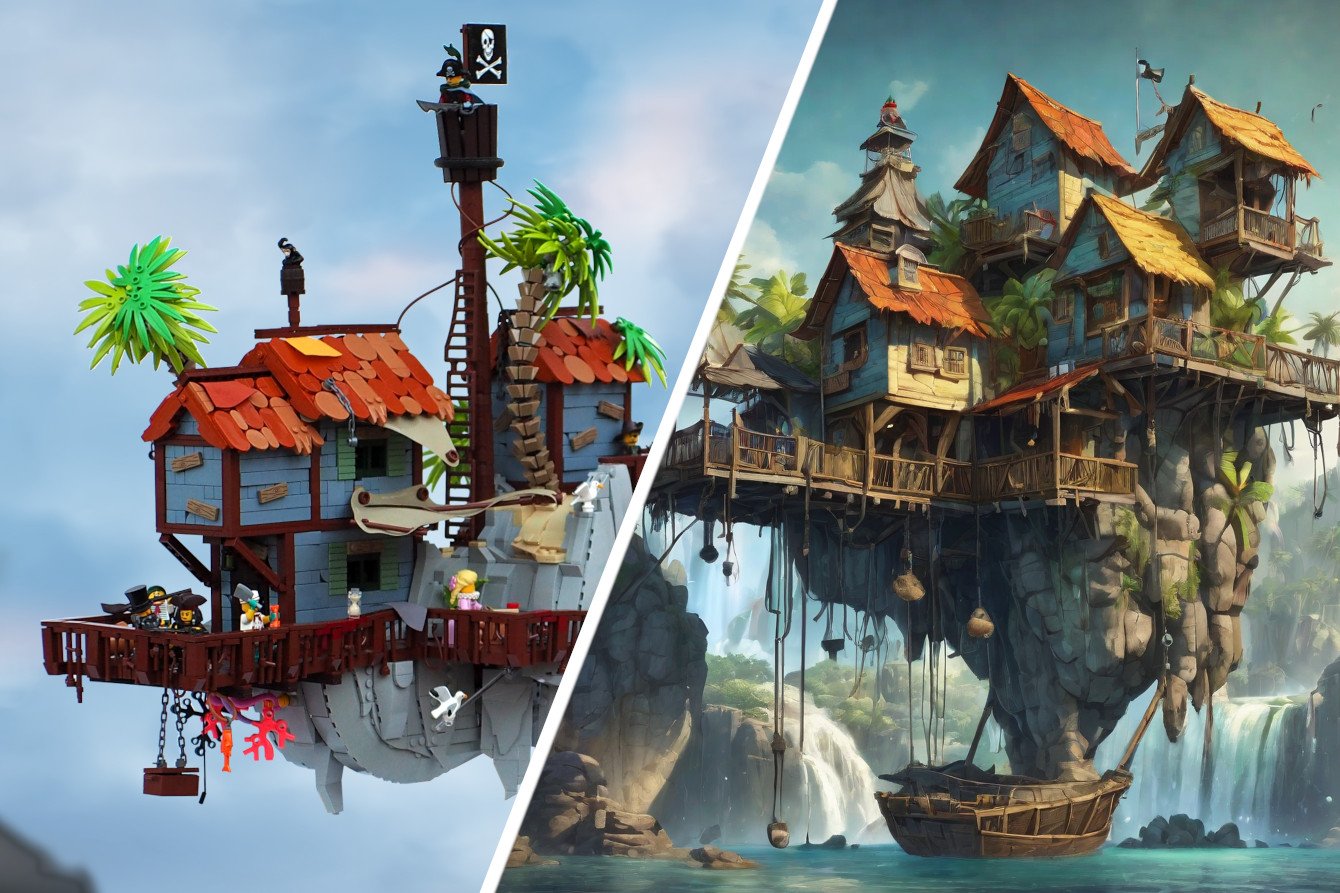



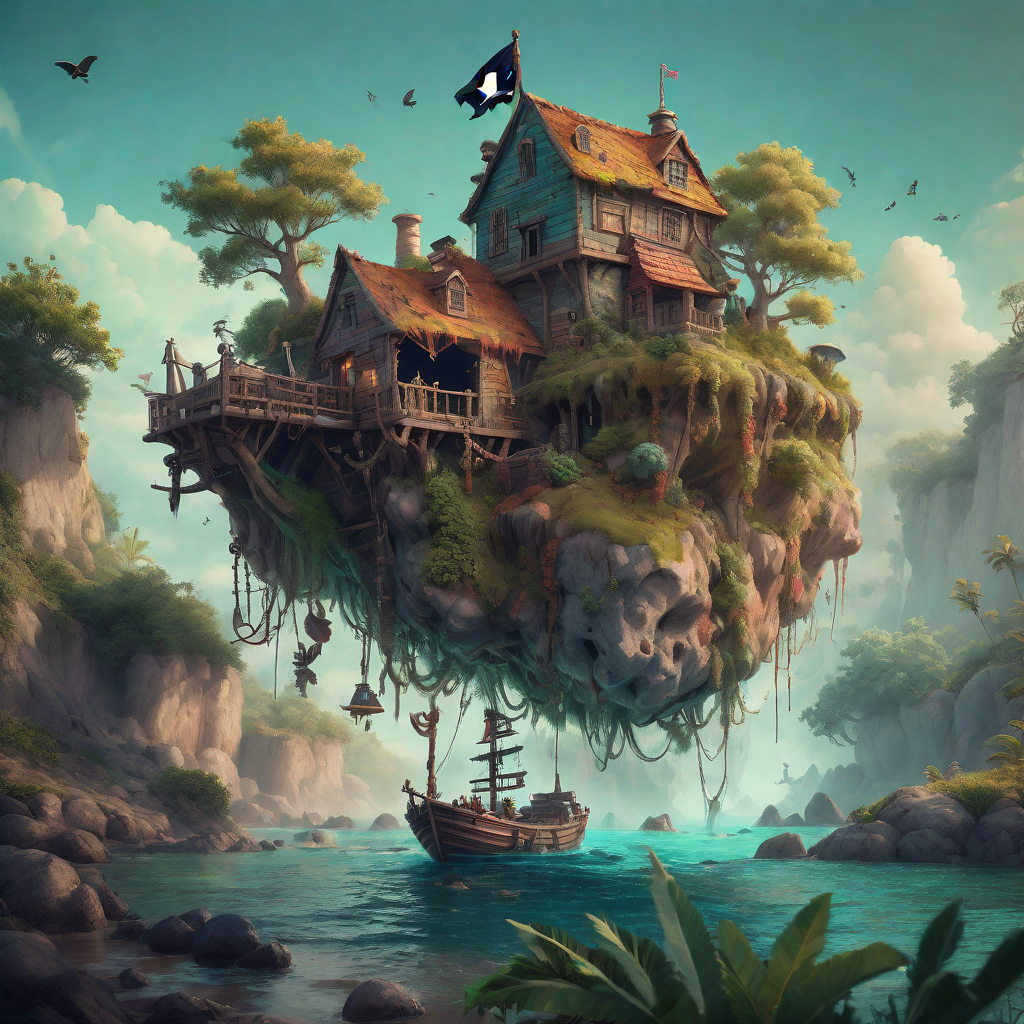
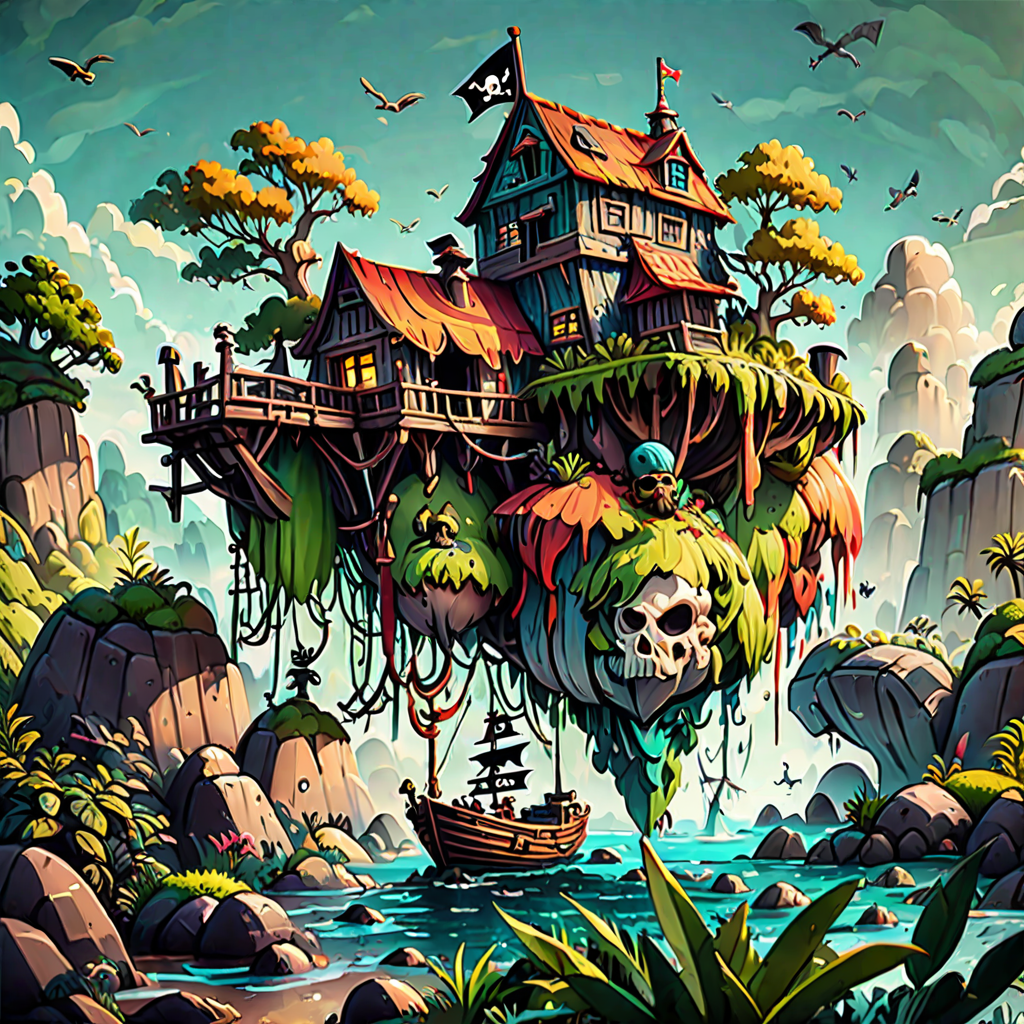
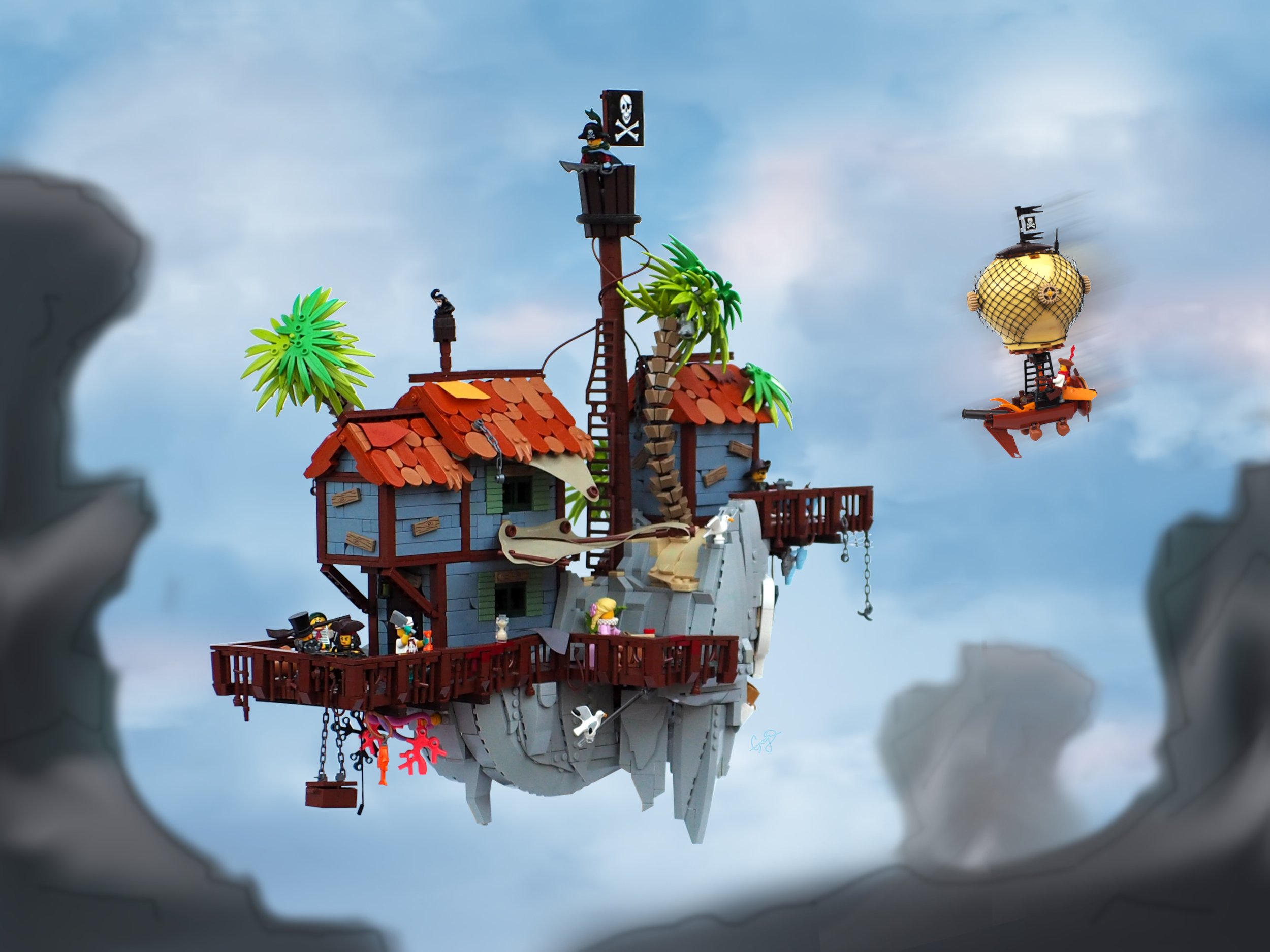
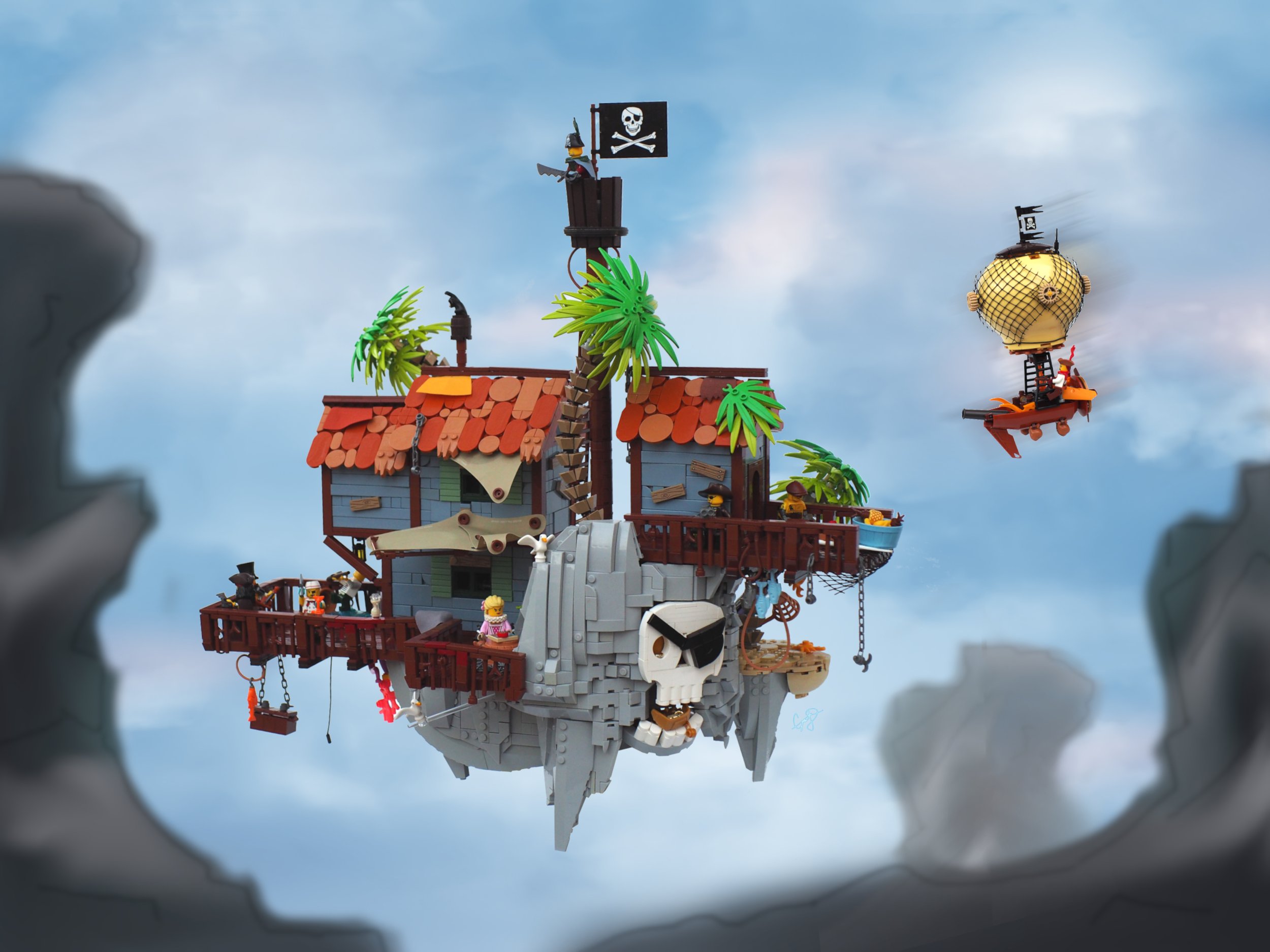
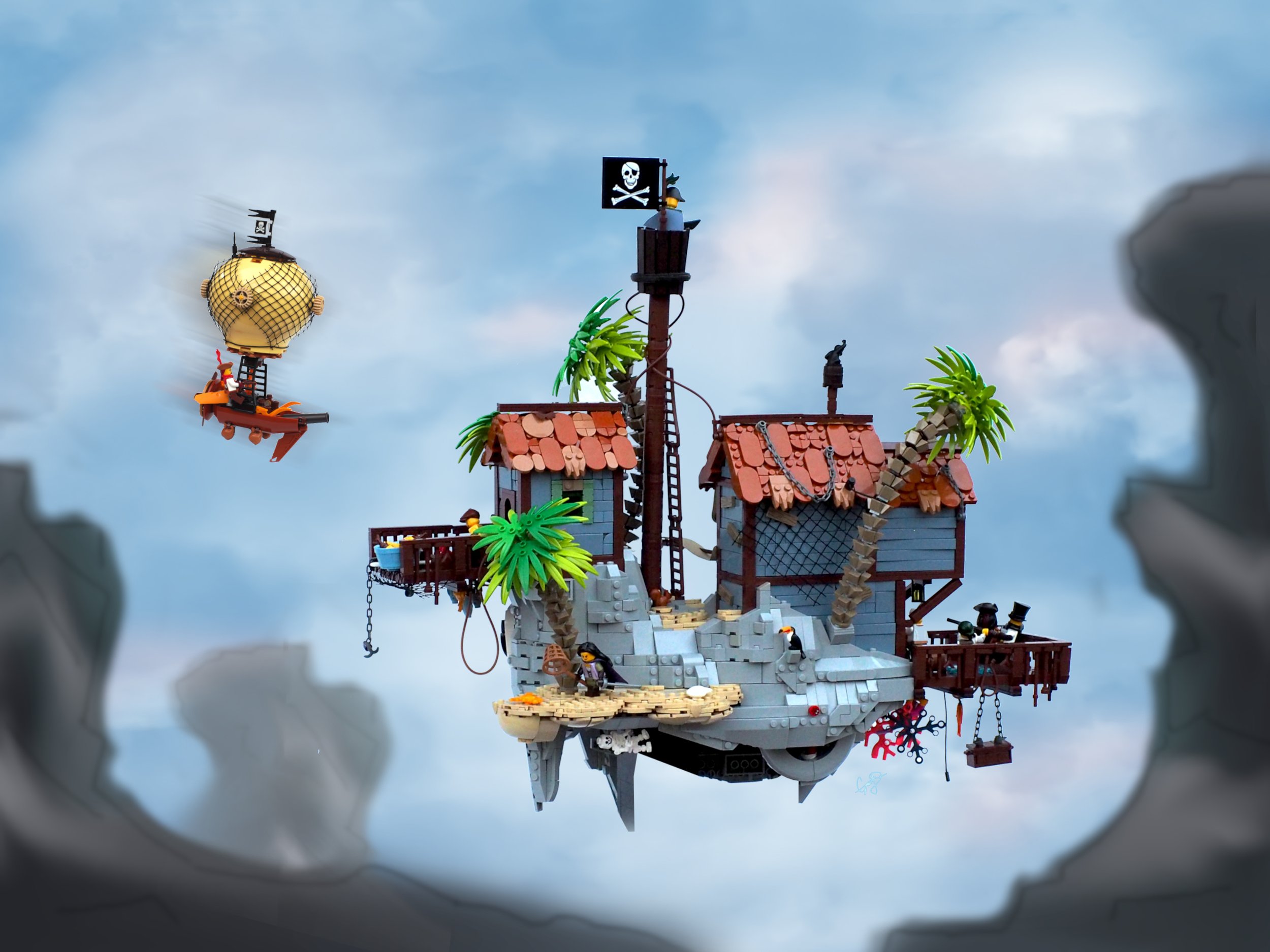

Theoretically, AI could be trained to reverse engineer MOCs and create instructions, or at least to break a digital build into logical instruction steps. I find the instruction-making process tedious, and I would be happy to have AI doing it instead of me.
AI can also help with MOC presentation, providing free, unique backgrounds like the MOCs below. If trained specifically for this, it could potentially do an incredible job, matching lighting and angle in a way that’s very difficult to achieve with stock photos.
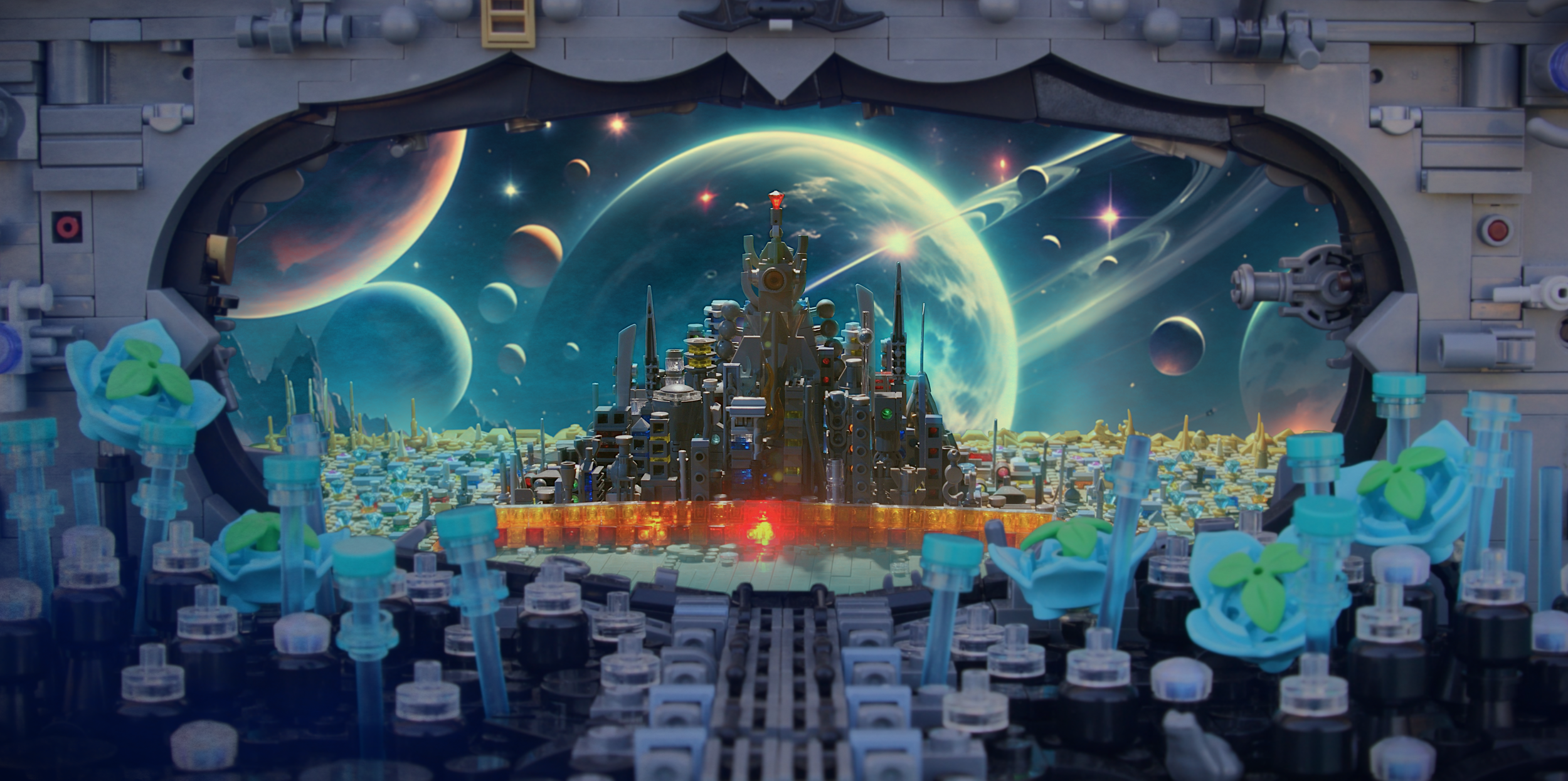

So like any good tool, AI has the potential to take over some of the less exciting parts of the building experience, freeing us up to spend more time actually clicking bricks together.
AI and Creativity
One of the points made in our previous article was that AI inspires creativity. That combination of words got me thinking. Inspiration and creativity—polar opposites in this context, but practically used as synonyms… which is ridiculous. To the extent that you got inspired from somewhere else, such as AI, you didn’t create it yourself. Inspiration, to be fair, has two (nearly opposite) definitions: one is the inspiration that comes from something tangible and definite outside of yourself; the other is the inspiration that descends from no one knows like a breath of genius, and is fairly synonymous with creativity. But the inspiration that can come from AI is clearly not the breath of genius inspiration, so I think my point stands that talking about AI inspiring creativity is meaningless rhetoric.
Even AI can’t quite tell the difference between creativity and inspiration when asked to depict it visually. (DALL-E)
Now defining creativity is nearly as difficult as defining life: but at least we can say that creativity is more than just remixing a jumbled mess of experience. Whatever creativity is, AI makes for a good negative definition of what it is not: creativity is not the output you could get from stuffing data into a machine. Creativity brings something unique to the table. A case could be made that if you could find out where it came from, it would no longer be creativity.
Creativity implies something a little bit “ex nihilo”—out of nothing—or more accurately, out of the creator’s personality. It is not the part of a work that you can trace to those definite and tangible sources of inspiration we mentioned earlier: instead, it’s the part of a work that most deeply expresses yourself. It’s what would have been different if someone else, even your identical twin, had produced the work.
(Of course, underlying this definition of creativity—if you are generous enough to call that a definition—is a denial of philosophical materialism. Supposing there was nothing immaterial, such a concept of creativity is out of the question: humans are only machines, and a fully developed AI will be as creative as a human; possibly more so.)
The definition of creativity is a crucial part of the answer to the question, “Can AI replace humans?” and our more specific question, “Can AI replace human creation of LEGO builds?” If it is true that creativity is a product of personality, then an impersonal tool will never be able to replace the human touch in the making of art. It may be technically superior in a given instance, but it will lack the appeal to personality that creativity (because it springs from personality) would lend it.
AI and Art
Besides the personal element in creativity as discussed above, there’s another critical component to art that AI cannot touch. Before we get into that, we need to take a brief excursus into the whole is-LEGO-art question.
Of course, the short answer is yes. After all, the dictionary definition of art is “the conscious use of the imagination in the production of objects intended to be contemplated or appreciated as beautiful, as in the arrangement of forms, sounds, words, [or LEGO bricks].” Okay, so I added the last few words. But seriously—building with LEGO ticks all the boxes for art when defined as a product of the imagination intended to be beautiful. So sure, every LEGO build is art, the same way your toddler scribbling on a sheet of paper and then holding it up for your admiration is art.
Scribbles as art? (DALL-E AI generated image)
There’s got to be a narrower definition of art, however—the kind that goes in museums and is admired for centuries. I think we’ve seen some LEGO builds that qualify to be considered as that type of art, but they’re few and far between. This is because Art, as distinguished from the dictionary art quoted above, is really not about imagination or beauty as much as it is about conviction and emotion. Art with a capital A stirs us, motivates us, and inspires us. So in that sense, not all LEGO creations are Art.
But some are. And the crucial element in Art—the element of meaning—is something that AI cannot reproduce. A human could possibly get AI to create a picture that did in fact convey meaning or capture emotion—but only by selective guidance. The Art, then, comes from the prompt and the intention, not from the machine. AI has no convictions, emotions, or intentions, all of which are critical for creating Art.
AI and Honesty
An important part of the AI debate has to do with ethical concerns. First of all, AI is generally trained using copyright material (in some cases, even private material). Of course, I as a LEGO builder have also been “trained” on a lot of copyright material—LEGO sets, MOCs by other builders, and concept art. No one questions the reasonableness of an artist adding to their education by observing and critiquing other artists’ work. Provided the artist’s own work is sufficiently distinct to avoid plagiarism, building an inventory of techniques and concepts from which to invent your own art is an acceptable use of copyright material and even one of the primary uses of copyright material.
But this is arguably because as an artist you bring something of your own personality to your works of art, thus making them uniquely distinct in a way that AI cannot. (Again, the argument falters if you approach the debate from a materialist perspective and don’t believe that human personality brings something to the creation process that is not a product of influences reproducible within AI.) The question then becomes, is it right for someone else to make a profit off a machine that is essentially chopping up copyright material, mixing it up, and spitting it out again?
Of course, the issue is complicated by the fact that there is a lot of non-copyright material for AI to learn on. Now if I were developing an AI, I’d make avoiding copyrighted material part of my concern but more from an excess of caution than because I’m convinced that using copyright material to train AI is theft. After all, not all human writings or drawings are necessarily “art” or creative enough to be distinguishable from AI productions. Translated into LEGO, what I mean is that while some of my MOCs are art, others are pretty much just rehashes of a medley of other people’s concepts and techniques. But that’s certainly not copyright theft, so is it necessarily copyright theft in AI’s case?
Another theft concern especially relevant to the LEGO side of the question is the potential for generating instructions using AI. If an AI capable of reverse engineering MOCs and creating instructions for them is developed, that obviously opens significant potential for theft.
Result when an AI is asked to generate building instructions for a horse. We don’t have much to worry about… yet. (DALL-E)
There’s one more (currently more relevant) side to the honesty question, and that is honestly giving credit where credit is due, something that BrickNerd tries incredibly hard to do. If you’re generating AI “MOCs,” credit yourself as a brilliant prompt crafter if you like, but don’t take credit for building it. Preferably, refrain from using the term MOC, which literally means My-Own-Creation.
AI and Problem-Solving
Possibly the one thing that at once unites LEGO builds and distinguishes them from other forms of art is problem-solving. As I argued in my Confessions of an Anti-Digital Builder several years ago, problem-solving is an essential part of LEGO building since it’s always necessary to work within the limitations of the system. So even the most minor LEGO creation has to overcome obstacles in order to stick together. This makes it valuable as an achievement in a way that an AI “MOC” clearly is not valuable. Certainly for personal satisfaction, AI cannot replace doing it yourself.
I have an interesting question on this subject: is AI capable of problem-solving at all? Consider math for an illustration. Obviously, any computer could tell you what 2+2 is or solve far more complex equations. But could an AI have invented calculus?
Well, I’m no mathematician, so I only plant the question. There’s a category of problem-solving that proceeds along the beaten path (like 2+2=4, 4+4=8, and so forth), but there is another category that is really problem-solving because it poses a new and unusual challenge that must be approached differently—maybe creatively. Frankly, I don’t know whether it’s theoretically possible for AI to solve those kinds of problems or whether they require a creative—personal—approach. I would tend to think that real problem-solving is beyond the capacity of AI… but would that mean that developing new building techniques is outside AI’s capacity, too? I don’t know.
What I am sure of is that problem-solving in that more complex sense of striking off the beaten path is a big part of what makes LEGO building so attractive. Life, like LEGO blocks, is full of odd little pieces that don’t seem to fit anywhere. Doing the best you can with what you’ve got is the essence of LEGO building, and the beauty of LEGO building is that sometimes the final MOC is better because of the very limitations you were working with. What every LEGO MOC builder seeks to achieve is something big out of a lot of something small—the pleasure of being the architect of that process is great enough to make building a valuable experience (even if AI “MOCs” out-compete your MOCs for Insta likes).
AI and Community
If AI is ever paired with building software to create digital “MOCs” or, more indistinguishable still, create instructions that can then be built physically and photographed like any human-made LEGO build (remember the mosaic-building tool mentioned earlier which could do exactly that), the disturbance will be profound. If the LEGO community argues whether or not it’s acceptable to use string not manufactured in Billund, they will undoubtedly debate if what you’ve built with AI counts as a LEGO creation. For some reason, it’s hardwired into LEGO builders to care intensely about the integrity of the building process—and although our disagreements are usually friendly, they’re still disagreements. What lines will we draw, what lines should we draw, and more critically, what should our attitude be toward those who draw different lines?
I mean, it’s a cute dragon, but obviously not built out of LEGO bricks [generated using AI.]
(Keep in mind that I’m envisioning a future here where AI is more advanced than at present and can generate images that fit the requirements of the LEGO system, thus indistinguishable from digital MOCs, or AI capable of generating instructions that can be built and photographed or displayed, thus indistinguishable from a physical MOC. Today’s AI-generated “LEGO” images are easily recognizable as such by anyone with the slightest acquaintance with LEGO.)
For starters, there is simply the fact that as the process becomes easier, the quantity will increase. AI LEGO builds will compete with MOCs for finite viewing time and space, easily at a ratio of 10:1 or higher, and your 7934th follower may never see your work or just give it the briefest of glances before swiping on to the boatloads of AI images that come after it. After all though, this is just an exacerbation of a problem the LEGO community has already begun to feel with the explosion of builders that has come in recent years: there’s just too much out there to see it all, and you have to be disciplined enough to see what you want to see and avoid places and sites that overload you with content that you find less inspiring.
As the LEGO community has grown, it has necessarily become less close-knit. Builders group themselves around interests, location, or other priorities. (Of course, that’s always been true, but from my perspective, builders are increasingly less aware of—and less interested in—other groups.) Leaving a comment on every good MOC out there, or even just seeing every good MOC out there, has become impossible, so interacting with a small group, sharing meaningful feedback and working toward a common goal together has become the norm. Putting aside my interactions with builders that come from interviews for BrickNerd and other places I write for, I believe it’s accurate to say that I interact with fewer builders today than I did ten years ago—but I generally have a closer level of interaction with those I do keep in touch with. This isn’t a problem, it’s just a difference. And it’s a difference that AI LEGO builds will exacerbate as it becomes increasingly of interest to actually know a builder in order to know what their process is like. (Imagine giving a bulder feedback on their technique only to learn that the creation was AI-generated. What a waste.)
AI-generated spaceship. (DALL-E)
So I foresee AI builds as giving an additional impulse to a trend that’s already begun, a trend that’s pushing LEGO builders into small groups. It’s a trend that dovetails with the way social media in general is going: the big public sites are becoming ways to follow celebrities and influencers, while interaction with friends is increasingly taking place in private messages and networking apps. One thing is certain: we’ll continue to find ways to connect even if AI LEGO builds take over social media.
Beyond that, I’m not sure I can predict anything. It will be interesting to see what standards LEGO conventions place for displaying builds based on AI instructions, or whether sites that blog MOCs will expand to blog AI-generated LEGO builds, or how LEGO builders themselves will react to AI LEGO builds—especially to physical builds made from generated instructions.
AI and MOCs
Though I can’t foresee exactly how the LEGO community (especially the building community) will react to AI LEGO builds, I can give some advice.
A clear distinction can and should be drawn between builders who create their own MOCs and those who use AI-generated instructions (or who simply post AI-generated images). This distinction is not even remotely the same as the distinction between physical and digital builders. Both physical and digital builders are engaging in a creative process. AI “builders” are not. The difference is far more comparable to that between LEGO fans who build sets and fans who build MOCs. There’s absolutely nothing wrong with just building sets—but it’s a different experience and it’d be silly to pretend like the experience of set building is equivalent to the experience of MOC building.
Equally, to suppose that AI builds allow more people to experience MOCing is inaccurate. MOCing includes the creative process of development and a personal touch, and this is the part of the process that AI takes over. While it may seem beautiful and inclusive to consider AI as a step toward what has been called the “democratization of MOCing,” in fact, AI is a replacement for MOCing. AI does nothing toward making MOCing more accessible; it merely allows those who haven’t got the time, inclination, or perhaps talent for MOCing to sidestep it. Let me repeat: there is nothing wrong with this. The world would be a really annoying place if everyone had exactly the same interests and talents. By all means, if you like building with LEGO bricks but don’t like coming up with your own creations, buy sets or get AI to design instructions for you. If you like seeing LEGO creations but don’t like actually putting bricks together, absolutely use AI to generate some cool images. But please realize that you’re not a MOCer as much as an idea generator.
I feel especially involved in this discussion, since I championed the democratization, if you will, of MOCing—leveling the playing field by lowering expense—in my Confessions of an Anti-Digital Builder. Therefore I think it’s worthwhile to belabor the point that AI LEGO builds are not MOCs and do not offer a comparable experience to MOCing, anymore than owning a robot that can lift half a ton is the same as being a champion weightlifter.
So for those of us who are MOCers, there’s no need to feel guilty for recognizing that AI builds are not comparable to our MOCs for personal expression or achievement. That can help us recognize them for what they are (or could be): cool builds that are a simple stepping stone into the LEGO system.
For those interested in using AI to build, I’m sure it could be a really fun experience and a great way to build up a city or other cool display in your basement. But know there’s more out there if you someday want to turn your enjoyment of plastic bricks into an art, not just a pastime.
AI and LEGO Sets
After what I said above about using AI-generated instructions being comparable to building a LEGO set, someone may have started to worry about all those designers’ dream jobs at LEGO Headquarters in Billund, Denmark. No need; they’re not going anywhere anytime soon.
AI-Generated brick-built cat set (DALL-E)
This goes back largely to the point about intentionality made earlier. Simply put, AI doesn’t have any ulterior motives. And though that may sound like a good thing, when it comes to art, it just takes all the flavor out of it. If you’re not aiming to achieve anything with your art—no emotion you’re trying to evoke, no inspiration to awake, no conviction to convey—you won’t achieve, evoke, awake, or convey anything. But LEGO sets are meant to delight and to inspire. It’s crucial that there be a human designer guiding the process. AI may possibly become a useful tool for iterating or generating instructions or what have you—whatever the software becomes capable of—but it can’t replace creativity and intentionality or using limits to inspire creativity.
Moreover, a huge part of a LEGO set is the building experience. Techniques as much as the final product are developed to delight the builder (unlike a MOC, where some builders suffer through the most painful techniques purely for the final aesthetic). Again, intentionality is critical for the building process to be enjoyable, and this, too, will make LEGO sets always superior to AI-generated instructions.
All that is not to say that the much cheaper development process for AI instructions (cheaper at least after the initial investment) may not force some changes in the way LEGO sets are developed. As to that, I don’t know enough about either side of the equation—how sets are currently developed and how well AI will do at generating instructions, if it ever gets that far—to make any predictions. But I think it’s safe to say that LEGO set designers are here to stay.
Will AI Replace Builders?
It’s time to come back to our starting questions. Will Artificial Intelligence impact the LEGO community? Yes, it surely will. As a tool, it may well change, streamline or improve the way we build MOCs. But since AI can’t create MOCs by itself, it can’t breathe creativity and personality into what it generates. At the end of the day, there is no replacement for builders. It can’t replace the sense of achievement that building gives us, nor can it capture the artistic vision we want to share with the world.
What does the future hold for LEGO fans? Maybe fewer likes on social media than we were used to, maybe some frustrations as we scroll past AI images with impossible geometry and shapes that LEGO bricks never came in. Maybe we’ll have to adapt to new software that makes MOC theft an even bigger problem, or face disappointments when AI builds get recognition in preference to our hand-crafted creations. If you build for likes or create instructions to make a quick buck, then yeah, consider switching to AI. But if you love the building experience, love the feedback loop, love interacting with other builders, don’t go anywhere. MOCing is an art, not a chore—and AI, like any tool, is just there to make the chores go by quicker so the art can get better.
Best of BrickNerd - Article originally published on February 19, 2024.
Is AI changing the way you build with LEGO? Share your thoughts in the comment section below!
Do you want to help BrickNerd continue publishing articles like this one? Become a top patron like Marc & Liz Puleo, Paige Mueller, Rob Klingberg from Brickstuff, John & Joshua Hanlon from Beyond the Brick, Megan Lum, Andy Price, Lukas Kurth from StoneWars, Wayne Tyler, LeAnna Taylor, Monica Innis, Dan Church, Roxanne Baxter, and Steven Laughlin to show your support, get early access, exclusive swag and more.


